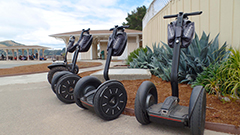How Segway Works
The Segway is a two-wheeled, self-balancing, battery-powered electric vehicle invented by Dean Kamen. The name Segway is a homophone of the word segue, meaning smooth transition. Computers and motors in the base of the device keep the Segway upright when powered on with balancing enabled. A user commands the Segway to go forward by shifting their weight forward on the platform, and backward by shifting their weight backward. The Segway detects, as it balances, the change in its center of mass, and first establishes and then maintains a corresponding speed, forward or backward. Gyroscopic sensors and fluid-based leveling sensors detect the weight shift.
 In 2011 the Segway i2 was being marketed to the emergency medical services community. The special police forces trained to protect the public during the 2008 Summer Olympics used the Segway for mobility.
In 2011 the Segway i2 was being marketed to the emergency medical services community. The special police forces trained to protect the public during the 2008 Summer Olympics used the Segway for mobility.
The Segway miniPro is also available to be used as the mobility section of a robot.
Disability Rights Advocates for Technology promoted the use of the Segway PT on sidewalks as an Americans with Disabilities Act of 1990 (ADA) issue. Segway Inc. cannot however market these devices in the US as medical devices and they have not been approved by the Food and Drug Administration as a medical device.
The maximum speed of the Segway PT is 12.5 miles per hour (20.1 km/h). The product is capable of covering 24 mi (39 km) on a fully charged lithium-ion battery, depending on terrain, riding style, and the condition of the batteries. The U.S. Consumer Product Safety Commission does not have Segway-specific recommendations but does say that bicycle helmets are adequate for "low-speed, motor-assisted" scooters. More details
 In 2011 the Segway i2 was being marketed to the emergency medical services community. The special police forces trained to protect the public during the 2008 Summer Olympics used the Segway for mobility.
In 2011 the Segway i2 was being marketed to the emergency medical services community. The special police forces trained to protect the public during the 2008 Summer Olympics used the Segway for mobility.The Segway miniPro is also available to be used as the mobility section of a robot.
Disability Rights Advocates for Technology promoted the use of the Segway PT on sidewalks as an Americans with Disabilities Act of 1990 (ADA) issue. Segway Inc. cannot however market these devices in the US as medical devices and they have not been approved by the Food and Drug Administration as a medical device.
The maximum speed of the Segway PT is 12.5 miles per hour (20.1 km/h). The product is capable of covering 24 mi (39 km) on a fully charged lithium-ion battery, depending on terrain, riding style, and the condition of the batteries. The U.S. Consumer Product Safety Commission does not have Segway-specific recommendations but does say that bicycle helmets are adequate for "low-speed, motor-assisted" scooters. More details
